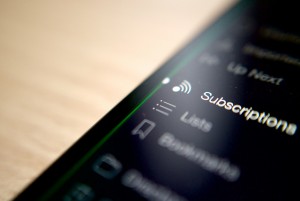The business world has changed in tremendous ways over the past couple decades. It has become increasingly more and more high-tech and high-touch. This technology has allowed for a new focus utilizing data in ways that were only imagined a decade ago. Businesses are now able to connect with the consumers at the beginning of supply chains and create high quality personalized experiences throughout.
With the changes in technology, businesses have an tremendous opportunity to transform and increase their market share. But be careful not to think change is a luxury, business is changing and those businesses that don’t adapt will be left behind. Whether you are actively altering your strategy to meet changes with consumers and technology or are dragging your feet and making changes begrudgingly, you will need to understand and address these issues or you will be left to watch your forward thinking competitors increase their market share.
First the Internet, and then smart phones, gave consumers increasing amounts of accessibility to brands and product information. Over time consumers have come to demand quicker and easier access to products, as well increasing amounts of information about the goods or services, which items are available and help choosing between them.
In fact, brands must now understand that it is their consumers who are dictating what a company must do in order to receive their business. The old school model of cutting prices to entice consumers had evolved as modern brands now use data to understand their consumer’s preferences and deliver exceptional, personalized shopping experiences based on what their consumers want.
Mobile applications are a perfect medium to deliver personalized shopping experiences to your customers. Before you start your iPhone application development project or your Android application development project. make sure you understand what modern consumers are looking for and incorporate these features into your applications.
Customization
At one time people sought to ‘fit in’ with their peers, but times have changes and more and more we see that the cool is now days based on individual style. The modern consumers is partial to exclusivity. Businesses must understand this and design their mobile applications in a way that allows consumers to account for personal preferences. There are a couple ways to do this, the first is to offer customizable products to you customers. This may not always be feasible, nor may it be the right approach for your business. Another way that you can offer customization to your customers is through targeted marketing strategies and options for users to customize their shopping experience. A simple change like giving your customers options to control push notifications can result in a big improvements in engagement. But don’t stop there, industry leading apps offer curated choices for users and smart navigation that can transform a mobile device into a powerful shopping tool. Mobile apps can be programmed to learn the preferences of users over time and then customize product suggestions to each user’s preferences.
New and Now
Consumers no longer just want something new, they want something new right now. Businesses now must offer fast and faster delivery as consumers are not just looking to buy something new, they want it to arrive immediately after they make the purchase. The Internet and smart phones are perfect tools to cater to your customer’s desire for instant gratification as you can either deliver content instantly to their mobile device or you can give them real time updates on shipping or their product to keep them involved in the process.
The Line Between Regular Life and Work has Blurred
We are seeing lines between work hours and personal time eroding as smart phones allow people to work anytime and anyplace. The Internet and mobile devices gives people the option to spend work traditional hours at leisure and to opportunity to address work issues in the hours normally thought of as being for personal time. Our lives is becoming more integrated, which creates new opportunities for marketers in determining ways to make contact with consumers and their changing lifestyles.
Savvy businesses are embracing the opportunities this technology present and their ability address the needs of the modern consumer.
While mobile marketing is relatively new, it has advanced by leaps and bounds in just a few short years. In the near future expect to see tremendous growth in this area including items such as mobile point-of-sale promotions and other in-store strategies leveraging the strengths of data and mobile devices.
Information has always been important in business and no time more so than now. Businesses need to be as informed as possible about their consumers to be able to target marketing strategies that will appeal to them. The more specific and personal that businesses can be with these strategies, the better the results will be.
Many brands are yet to capture the data available through their customers mobile shopping experiences and to utilize it to improve their users experiences, but as mobile marketing continues to mature the businesses that do not adapt to their customers will be left behind more strategic and forward thinking competition.
Photo: http://bit.ly/1CHC18c




